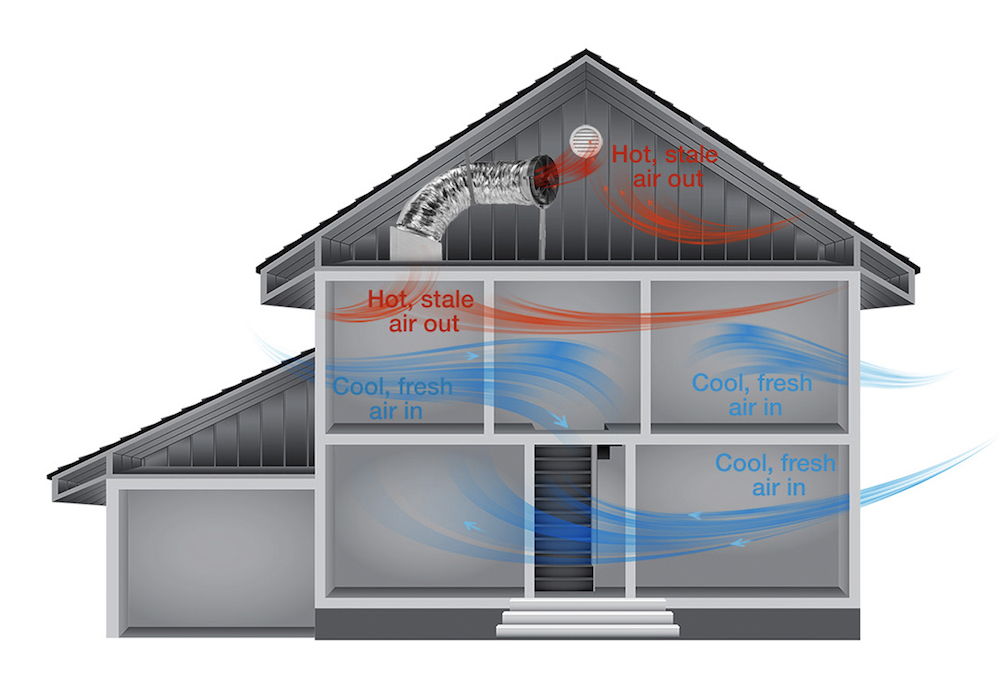Table Of Content

The low forecast is exactly what you need to pay attention to when running an Advanced Whole House Fan. There is a huge change between the high of the day compared to the low of the day in practically all locations in the US. It can range anywhere from 20 to 50 degrees difference, and in some cases, even more. This is why Advanced Whole House Fans Work in just about every climate zone. As soon as that temperature swing kicks in and it cools off outside, it is the perfect time to run your Advanced Whole House Fan.
Highly Energy Efficient

Many homeowners even build insulated boxes that they put over the whole house fan during the cold season. Traditional whole house fans are installed on the ceiling of the uppermost home level, usually in the middle of the home with the attic directly above it. My #1 top pick for the best whole house fan goes to the Energy Saver by QuietCool. This ultra efficient whole house fans come in a several models from a low of 1,434-cfm and up to a whopping 6,878-cfm for large homes. Whole-house fans are difficult to install, as they often require the installation of a new circuit and switch and may involve cutting into floor joists or your roof. Whole-house fans typically run on a belt-drive motor or direct-drive motor.
Q: How Many Windows Should Be Open To Run a Whole House Fan?
An Advanced Whole House Fan is used for cooling both the home and attic. In our current times, indoor air quality is one of the number one concerns of homeowners. With an Advanced Whole House Fan, you are able cool your home while improving the indoor air quality to create a cool and comfortable environment. A properly sized Advanced Whole House Fan completely exchanges the air volume inside the home every 3 to 4 minutes. Rather than sitting within a solid shroud, the fan fits inside a series of rings to allow more airflow with less restriction and improve efficiency.
BRING FRESH AIR IN
“Improving the energy efficiency of buildings in which we will live and work will save Californians energy for decades,” said Energy Commissioner Karen Douglas. It is also important to note that insect screens on gable vents substantially reduce airflow. The whole house fan takes advantage of this stack effect, and sucks out all of the rising hot air from the home interior. Homeowners can also control the direction of airflow in the home by which windows they choose to open. If you want a strong breeze in one particular bedroom, then just open the windows in the bedroom.
Q. Are whole-house fans effective at cooling?
The 4 Best Towers Fans of 2024, Tested by Real Simple - Real Simple
The 4 Best Towers Fans of 2024, Tested by Real Simple.
Posted: Fri, 02 Feb 2024 08:00:00 GMT [source]
Another good midsized option, this Quietcool model is capable of delivering 4,195 cubic feet of air per minute and is appropriate for homes up to 2,250 square feet. Its brushless motor is a feature we always appreciate, and will last longer and work more efficiently than brushed versions. In high humidity and desert regions, Advanced Whole House Fans are the most effective during spring and fall for cooling benefits and year-round indoor air quality benefits. Due to humidity, you wouldn’t want to run your Advanced Whole House Fan for cooling during summer. Many homeowners may think their house will get dustier by running the Advanced Whole House Fan. However, due to the amount of air an Advanced Whole House Fan moves when properly sized to the home, dust does not have any time to settle in the home!
There are other brands that make traditional Advanced Whole House Fans but it depends on the needs and preferences of the person who wants to buy a fan. I would suggest looking into different brands and comparing their features and customer reviews to see which one might fit your needs the best. You might also find it helpful to talk to a local HVAC expert or home improvement expert. They can help you figure out which brands and models are best for your home. With new viruses emerging and homes and buildings being built tighter and tighter, it is very important to make sure the air quality inside your home is good.
Other Whole-House Fan Cost Factors
Replacing the “Attic Fan” – the modern whole-house fan is gaining more popularity as an effective tool to cool homes due to its many innovations and improvements. Today, we explain the three basic types of whole-house fans, the pros and cons of each type, and finally, help you select the best-rated and best whole-house fan for your home. Use of an attic fan is easy because it goes on or off automatically via a thermostat. A fan, especially located near bedrooms, can detract from the quality of your life (and sleep).
As reported by Home Energy Magazine, a better way to install a whole house fan than cutting a joist is to install an H-bracket, which allows you to install the fan above the ceiling joists. Even though this will lower efficiency a bit, it may be preferable to cutting a joist. One of the most important things to look at when buying a whole house fan is it’s CFM rating—this stands for Cubic Feet per Minute. Solatube whole house fans are also rafter-hung in the attic which makes them super quiet.
It pulls cool outdoor air inside through open windows and doors and circulates it throughout the house. The fan draws warmer air in the house up into the attic where increased pressure pushes the hot air outside through roof vents. An attic fan expels the hot attic air far more effectively than passive attic vents working on their own. A quiet Advanced Whole House Fan is also known as a modern or advanced type of ventilation system that is made to make as little noise as possible. Many modern Advanced Whole House Fans are made to be quiet, but you should always do research and compare different models to find the one that fits your needs best.
With our patented design, robust aiflow, and reliable production, you can experience supreme cooling. The belt dampens much of the chatter and vibration, as long as the belt is in good working condition. "So, a landslide can be active over a period of weeks or days or months."
Attic fans pull air from the outside through existing vents in your attic. This allows your attic to stay within 10ºF of the outside temperature at all times when the fan is running. Without an attic fan, your attic can get up to 150ºF during the summer, which can ruin the integrity of your home and cause high electric bills. Once a homeowner decides on the type of fan that’s best for their needs, the next decision is whether to get a direct-drive or belt-drive fan. Direct-drive fans have motors mounted directly to the fan blade (somewhat similar to a ceiling fan or box fan). Belt-driven fans are standard whole house fans that have separate motors, with belts connecting the motors to the fans.
All whole house fans should be installed with rubber or felt gaskets to dampen noise. You can set a multi-speed fan to a lower speed when noise is a problem. The QuietCool System is a multifan, multilocation system that moves 1,500 CFM of air per fan through a ducted system, much like a forced-air heating and AC system. It is easy to install and has insulated self-closing damper doors to prevent unwanted air loss. Belt-drive whole house fans that use an integrated pulley provide for a smoother and quieter operation than direct-drive fans. Old whole house fans tended to be noisy, consume considerable energy, require frequent maintenance (belt-driven ones need the belts changed periodically), and are not well insulated.

Thus, the loop needs to remain open for your house to maintain a cooler temperature. Consider a different cooling system if you aren't comfortable leaving windows open at all times during the summer months. When the scorching heat of summer settles in, finding ways to keep our homes cool becomes a top priority. Air conditioning is the go-to option for many, but it can be expensive to run continuously, and not everyone can afford the higher utility bills. In this quest for cost-effective cooling solutions, the whole house fan emerges as a viable and energy-efficient alternative.
These are also more energy-efficient, meaning you’ll spend less on monthly utility bills to run a direct-drive whole-house fan. To Determine the Correct Size of the whole house fan for your house, we first need to determine the CFM (cubic feet of air movement per minute) required to cool your size house effectively. The formula recommended by the Department of Energy, PG&E, and the California Energy Commission states you should move your air volume 3-6 times per hour.

No comments:
Post a Comment